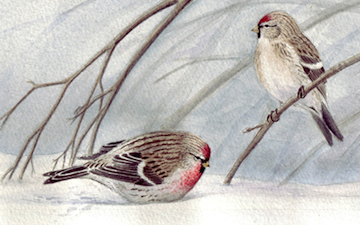The Common Redpoll, Carduelis flammea, is a species in the finch family. It breeds somewhat further south than the Arctic Redpoll, also in habitats with thickets or shrubs. Nominate C. f. flammea (Mealy Redpoll) breeds across the northern parts of North America and Eurasia. There is also an Icelandic subspecies, C. f. islandica, and one which breeds in Greenland and Baffin Island, C. f. rostrata (Greenland Redpoll). All forms migrate further south in winter into southern Canada, the northern USA and most of Eurasia. These birds are remarkably resistant to cold temperatures[1] and winter movements are mainly driven by the availability of food. The common redpoll is smaller, browner and more streaked than the Arctic redpoll. There are two distinct populations (one lighter, one darker) united in islandica, the relationships of which are unresolved[2].
(From Wikipedia, November 25th, 2010)
—
The Common Redpoll is a frequent and often abundant winter visitor across all of Alberta. As spring approaches, redpolls leave one and all for their arctic breeding grounds. Some redpolls breed in extreme northeast Alberta.
On their breeding grounds redpolls inhabit patches of scrubby birch and willow. In winter, redpolls can be found anywhere with suitable cover, including city parks and back yards stocked with suitable feeders.
When not gorging at feeders in winter stocked with their favorite niger seed or sunflower seeds, redpolls eat seeds of trees such as birch, and of grasses and other plants. They may also nibble from suet feeders, especially in winters where their numbers are high, and there is lots of competition at feeders. On their breeding grounds redpolls also feast on the explosion of buzzing insects that emerge, seemingly without respite in the Arctic summer.
Redpolls build a nest of twigs and grasses on the ground or in low shrubs. Four to seven pale blue eggs splotched with dark markings are laid and incubated for 10 or 11 days. Young are fledged in another 12 days or so.
(From Talk about Wildlife, November 25th, 2010)
—




